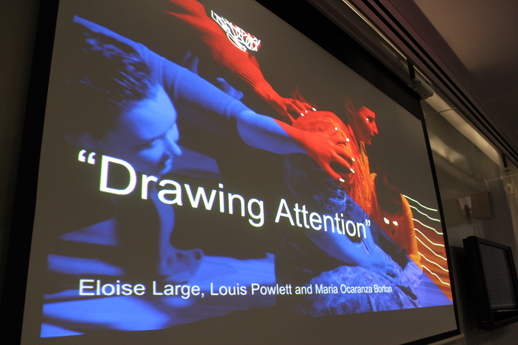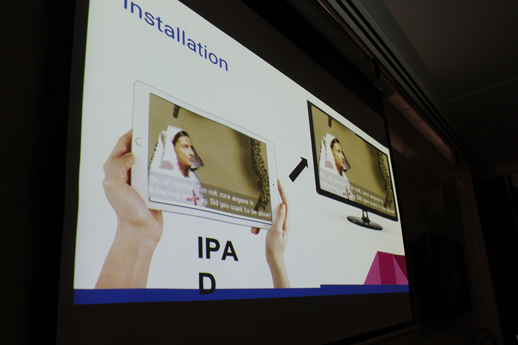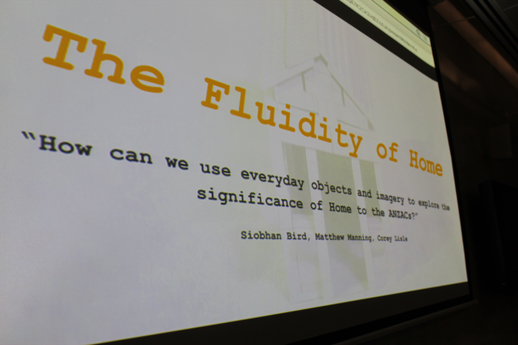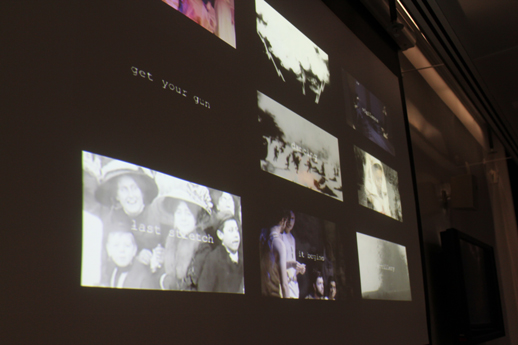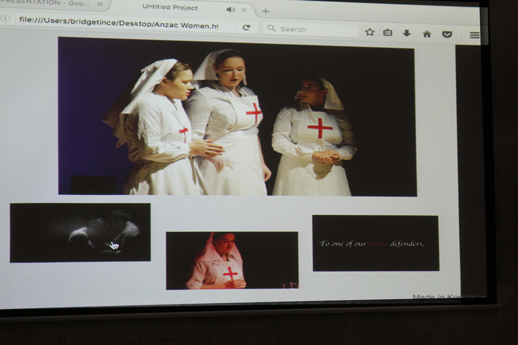Documentary Design i-doc installations from sethkeen on Vimeo.
Author Archives: sethkeen
Documentary Design Wk 12 Presentations
The studio started to drawing to a close with project groups presenting their k-films to the galley curator and studio for feedback. Some pictures from the presentations and current working titles for each k-film installation and the media producers who have made the works.
Drawing Attention 2016, k-film installation, Maria Ocaranza Bortoni, Eloise Large, Louis Powlett
Drip drop 2016, k-film installation, Yiwen Jiang, Chen-Lin Huang, Jack Worthington
Love in Times of War 2016, k-film installation, Arisara Aueviboonphol, Rachel Melisa, Ceyda Resuloglu
Immersive ANZAC 2016, k-film installation, Anna Miers, Margaret Tanjutco
The Fluidity of Home 2016, k-film installation, Siobhan Bird, Corey Lisle.
Wallpaper Women 2016, k-film installation, Mimi Hamra, Bridget Ince.
Documentary Interactivity
If you are looking for additional material to help you with your group report – then these notes compiled by Adrian Miles may be useful.
Video screen recording
There are some great tools for doing video screen captures like Shiny White Box which I use – but it is licensed software that costs.
Apple (as Louis points out) allows you do it simply with QuickTime (file > new screen recording).
Doc Design Wrap Up
OF KORSAKOW YO CAN DO IT!
update all links on personal assessment checklist to each item
i.e. sally smith example https://docs.google.com/document/d/1k-WJ1ovgV_DMiPT16ofbcpi3hL_tRIto5ILOR7YbCg8/edit
PB4
Presentation
and add the following to this “Student submissions>PB4>grp” folder.
https://drive.google.com/drive/u/0/folders/0B7fjYdo7IBfOTG90V0w4dy1fdm8
i. Add presentation ppt/text to folder (- ppt, text presentation notes)
ii. PB4 Report
11. Add to same group folder ‘readme’ file (contacts, text description, gallery install notes all in one doc)
PB4 K-film
Improve based on feedback from yesterday for assessment and gallery – run past changes with me over next 2 weeks – Submit to me USB/DVD with k-film export files only. (NB – Back up your Korsakow project for next year in case you have to update or make changes)
PB5
PB5 Media presentation
Studio video – aiming for sharp 5 mins to use for media presentation and gallery promotion (double dip)
Shared script (with timings)
https://docs.google.com/document/d/1s6E4xs8q3zwDdZfzj33tAKQAiJKEB_yKyJBhhy-bmRs/edit
(6 groups 40 secs min/max on each project…)
Structure – work from your text description if it helps – you are making a short video that will profile your work – feel free to show process and dip into the studio update pics/videos if helpful – https://drive.google.com/drive/u/0/folders/0B7fjYdo7IBfOZjFKN3JrRm1HYUk
Put your video section in gallery group folder (below) – let me know by email when it is there…
Text descriptors onto MF blog – finalise in g-doc and I will transfer to the project page – email me when it is complete…
https://drive.google.com/open?id=1BHLWQc2RvVGfvsmLDY7c9g8JfYk9f9Wu4P6_ifyTJFE
Media contribution 1-2 paragraphs – add to your personal diary last entry – add bookmark link to assessment checklist
PB5 Personal summary
this goes into your personal diary and you put a bookmark link in your assessment checklist
Gallery folder
https://drive.google.com/drive/u/0/folders/0B7fjYdo7IBfOXzVoZ0R0V1dBbjA
duplicate into your group folder (readme file, one image to promote your work as in text descriptor)
OF KORSAKOW YO CAN DO IT!
Review and review again
Hi everybody,
This blog entry on PhD to Start up? reminds me of what I tried to get across in the doco design studio this semester in terms of bringing design methodologies into the media production process…
With your final k-films – I have introduced you to sketching (keeping the design of something open to multiple ideas and potential external influences)…
in reference to the article below;
# don’t make the k-film from your desk – user test, run it past me, others – keep getting feedback (design is an ongoing conversation) and engagement with the client, the audience the real world…
# and “Don’t be passionate about your idea, be passionate about the problem you are trying to solve”
in this case the prompt you are aiming to address – this is the design problem you have set up for yourselves..
This is where people go back to the habit of fixating on an idea and loosing site of the whole, the context, the brief etc…rather than trying out multiple ideas/sketches to resolve the problem (i.e do a number of interface designs, move the previews around, try different colours in the background etc) chose the one that works best as response to the problem – what you are trying to communicate…get it looking aesthetic then user test…)
# Learn, Build, Validate, Review…and again, and again, and again
so many times I see media students complete their first iteration of a work then call the work finished – what I am seeing is a work at 50% of its potential – follow above and you will improve the work TEN fold (i,e look how far the Drawing Attention work has come in a week!)
studio update wk 9-10
The two week update from wk 9-10 is provided by Margaret Tanjutco and finds humour in the hard work phase of getting the k-film installations into shape. You need to keep your sense of humour when working with Korsakow.
WEEK 9-10 UPDATE:
Weeks 9 and 10 are all about the productivity and fine tuning required to get our final Korsakow projects finished and flabbergasting. It’s a race against time to make sure our presentations and projects are ready to be flaunted to Maroondah Art Gallery curator, Lisa Byrne, for her final bits of feedback before the ultimate submission.
Each group had the opportunity to receive consultations with Seth who kept us on track by offering his thoughts on how to better shape and sharpen our work. He made sure that we continually took into account the real-world implications of our projects – both in scale and in content. Playing with such a unique software and media format, his guidance was much appreciated. We also had the opportunity to work within an “open studio” – a helpful and much needed mode of tute which this type of project benefitted from greatly.
Of course the written assessment tasks were not to be forgotten either, manifesting itself as a reflective diary and project-based summary. The style of writing needed to take full advantage of the latter was also emphasised. We shall definitely not hold back on our hypotheses, fascinations, and criticisms surrounding beloved Korsakow.
We are well on our way to “crunch time” here at Documentary Design and we are so thrilled to have the opportunity to showcase our work at the Maroondah Art Gallery. We’re facing real life with real people and very real budgets. CAN WE DO IT? Of Korsakow we can.
Korsakow Autoplay
To autoplay in Korsakow you type this code after line 33 in the index.html file: flashvars.kiosk = true;
Critical reflection on practice
This video is useful for thinking about the critical reflection in regards to writing and structuring the PB4 report and aspects of your PB5 personal reflection summary. Key quote from the video:
“New interpretations of experience to inform practice…”
Notes from the video that can be used to structure a response to the prompt in the PB4 report:
Introduction
Context – local and global (the parts of the prompt ‘social media’, interactive documentary’, theory and practice examples)
Rationale framing the reflection on practice/the report (this refers to the prompt in some way).
Deconstruct the prompt and provide your perspective on where you think it coming from – within the context of this course and the media program, the research of the studio lead. Make connections back to the group research you did for project brief 1.
Evidence
How was the evidence collected? – through a process of engaging in practice and documenting the processes – the event and protoytpe aspects of the project (details of what? and how?)
Journey – timeline/narrative
Evaluation
Critical reflection
Analysis of main features of what took place
Strengths, successes, limitations
Outcomes – probable/possible
Conclusion
“Draw out implications for practice – how is it significant for you and others…?” i.e in this case media practice.
“reflect on the reflection…” “do the implications for practice arrived at make sense?”
Tips
Still provide evidence for your claims like a formal essay – i.e references
Do not speculate wildly without some evidence to back up your claims
Week 12 Presentation
Details for the final studio presentation to the gallery director/curator next week.
When is it happening?
Monday Oct 10 11.30-1.00.
What is the key aim of these group presentations?
The main aims of these presentations before the week 13 deadline are as follows:
a. Provide the curator with an insight into what might be expected as a submission to the gallery.
b. Provide the curator with ideas on how the work may be installed and work out what will need to be provided in advance to make that happen.
c. Use the opportunity to get feedback from the curator, studio lead and others to improve the work for gallery exhibition and assessment.
What is required for the Tuesday studio in week 11?
Use the Tuesday studio before next week to get feedback on how your presentation may be improved for assessment before presenting in week 12. This means pushing your presentation along as far as possible even if your k-film is still being built. This includes visuals of your installation idea.
What is the format?
The presentations will be 10 minutes long with 10 minutes feedback from the panel and studio.
Please note the presentations will need to run to time in regards to the bookings with panel guests.
The format for the presentations is open in regards to the use of slides and presentation tools, along with demonstrating your k-film prototype.
Groups will be expected to note feedback from the studio and use that inform the refinement of the final submitted work.
The final presentation and uploaded written presenter notes are to be submitted by Monday Oct 10 11.30-1.00. These notes will be placed in a shared (e.g. PB4 Group 1) folder.
Personal assessment checklists will need to be updated by all group members with a link to the presenter notes/slides etc.
How is it being assessed?
From the PB4 assessment sheet.
